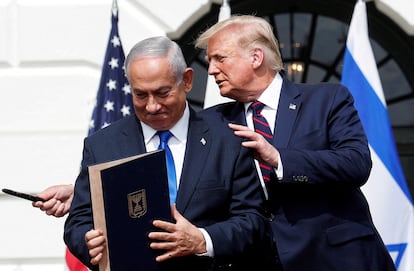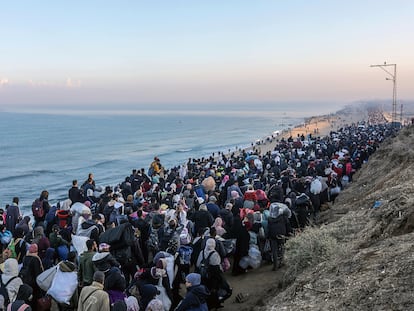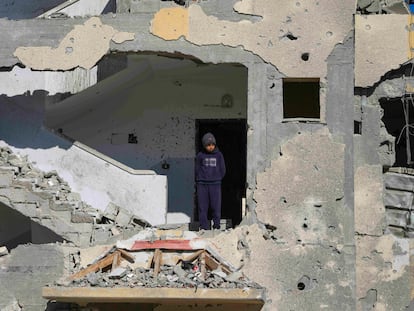Gaza ceasefire hangs in the balance as Trump and Netanyahu meet in Washington
The two allies will also discuss the U.S. president’s proposal to deport 1.5 million Gazans abroad, as well as Iran’s nuclear program

The highly anticipated meeting on Tuesday in Washington between U.S. President Donald Trump and Israeli Prime Minister Benjamin Netanyahu is set to shape the future of negotiations for the second phase of the ceasefire in Gaza. Talks between the parties — Israel and Hamas — were scheduled to begin on Monday. However, the day before, Israeli authorities announced that their delegation would not be traveling to Doha, Qatar, raising the possibility of changes to what was initially agreed-upon in the deal. The agreement outlines three phases, each lasting a month and a half.
On the eve of the meeting, Trump stirred concern among Arab leaders by stating that “Israel is a small country,” just days after suggesting that Palestinians should leave Gaza and resettle in other countries.
“It’s certainly a small country in terms of land. You see this pen, this wonderful pen? My desk is the Middle East and the top of the pen is Israel,” Trump told reporters at an Oval Office event. “That’s not good, it’s a pretty big difference.”
According to Politico, his administration is expected to halt funding for the U.N. agency for Palestinian refugees, UNRWA, which has been a target of Israeli criticism.
During Netanyahu’s visit to the White House — the first by a foreign leader since Trump’s inauguration two weeks ago — the two leaders will also discuss other, less urgent but equally critical issues for the future of the Middle East. These include the normalization of relations between Israel and Saudi Arabia, a process that was derailed by the outbreak of war following the Hamas attacks on October 7, 2023. Additionally, they will address Trump’s proposal to deport 1.5 million Gazans abroad, with U.S. allies Egypt and Jordan mentioned as possible destinations. Another key topic on the agenda will be strategies for countering Iran’s nuclear program and Tehran’s support for fundamentalist militias in the region.
The talks, after which both leaders are expected to hold a press conference, may also include Trump’s regional envoy, Steve Witkoff. Following his visit to the White House, Netanyahu is scheduled to hold separate meetings on Wednesday with National Security Advisor Mike Walz and Defense Secretary Pete Hegseth. On Thursday, he will meet with congressional leaders from both the Senate and House, along with other lawmakers on Capitol Hill.
Netanyahu arrived in Washington on Sunday. Israel’s ambassador to the United Nations, Danny Danon posted on X that the meeting would strengthen “the deep alliance between Israel and the United States.” Upon landing, the Israeli prime minister stated that his discussions in the U.S. capital would focus on achieving “victory over Hamas, achieving the release of all our hostages and dealing with the Iranian terror axis in all its components.”
Doubts about the agreement
The second phase of the ceasefire in the Gaza Strip follows the first six-week stage, which began on January 19. This phase includes the release of 33 of the 98 remaining hostages in Gaza in exchange for hundreds of Palestinian prisoners, as well as the withdrawal of Israeli occupation forces from the enclave and the handover of the remaining captives who are still alive. However, doubts loom over the implementation of this next stage, as Netanyahu faces mounting pressure from the most hardline members of his cabinet, who are demanding that the military offensive resume once the initial six-week period ends.
“These are critical moments in which I repeat my call to complete all stages of the deal and swiftly bring back all our abducted brothers and sisters — every last one of them,” Israeli President Isaac Herzog said during an event at his residence in Jerusalem, according to an official statement.
“There is no political reason preventing Netanyahu from going to the next phase,” opposition leader Yair Lapid said during a visit to Kibbutz Nir Oz, one of the communities devastated in the Hamas-led attack that killed approximately 1,200 people on October 7, 2023. Lapid was referring to the support he has pledged to offer Netanyahu’s government if the coalition loses backing from far-right members. “Netanyahu has a political safety net from the opposition for the deal—for every stage,” Lapid added, saying he had conveyed this directly to the prime minister.
“I’ve been saying since day one that Netanyahu and the thugs around him in the coalition and the government are not really interested in a ceasefire or saving the Israeli hostages — let alone saving the lives of thousands of Palestinians,” said Offer Casif, a lawmaker from the Arab-Israeli Hadash party, in statements to the Qatari channel Al Jazeera.
Trump has eagerly taken the lead in ceasefire negotiations, with his Middle East envoy, Steve Witkoff, joining the efforts. After teams from both the new administration and the previous Democratic administration of Joe Biden worked together to finalize an agreement — whose terms had been on the table for months without being accepted — the Republican president has claimed credit for the breakthrough, which he is keen to see move forward.
Perhaps for this reason, Trump may not be particularly receptive to Netanyahu’s plan to resume the war as a means of preserving his governing coalition. His priority is ensuring the success of the ceasefire deal, allowing him to shift focus to a long-cherished goal: normalizing relations between Israel and Saudi Arabia, the economic and spiritual leader of the Arab world. Such a step would serve as the crowning achievement of the Abraham Accords, which Trump championed during his first term, facilitating agreements between Israel, the United Arab Emirates, and Bahrain.
In any case, Netanyahu has Trump as his strongest international ally. A clear indication of this is Trump’s proposal to expel 1.5 million Palestinians from Gaza — an idea that took his Arab allies by surprise but was met with applause from the Israeli prime minister’s inner circle, particularly among the most hardline advocates of recolonizing the Gaza Strip, where Jewish settlements were dismantled two decades ago.
Israeli authorities have framed this population transfer under the euphemism of “voluntary emigration.” On Monday, a member of Netanyahu’s Likud party publicly endorsed the idea. “It is inhumane to live there at this time,” argued Moshe Saada in an interview with military radio, referring to the Palestinians — but not to the Jewish settlers already making plans for new construction. “These people have been refugees for 75 years. The time has come to rehabilitate them,” he added, suggesting that Arab nations — supported, financed, and encouraged by the United States with billions of dollars a year — should absorb them.
Trump’s proposal to relocate Gazans has sparked alarm across the Arab world, with regional governments swiftly rejecting the idea. Any plan that involves “efforts to encourage the transfer or uprooting of Palestinians from their land” would jeopardize regional stability and “undermine the prospects for peace and coexistence,” a joint statement warned on Saturday.
Meanwhile, Jordan’s King Abdullah II — whose country already hosts a significant Palestinian refugee population displaced by previous conflicts — plans to travel to Washington next week to meet with the U.S. president on February 11, according to an announcement from Amman.
Sign up for our weekly newsletter to get more English-language news coverage from EL PAÍS USA Edition
Tu suscripción se está usando en otro dispositivo
¿Quieres añadir otro usuario a tu suscripción?
Si continúas leyendo en este dispositivo, no se podrá leer en el otro.
FlechaTu suscripción se está usando en otro dispositivo y solo puedes acceder a EL PAÍS desde un dispositivo a la vez.
Si quieres compartir tu cuenta, cambia tu suscripción a la modalidad Premium, así podrás añadir otro usuario. Cada uno accederá con su propia cuenta de email, lo que os permitirá personalizar vuestra experiencia en EL PAÍS.
¿Tienes una suscripción de empresa? Accede aquí para contratar más cuentas.
En el caso de no saber quién está usando tu cuenta, te recomendamos cambiar tu contraseña aquí.
Si decides continuar compartiendo tu cuenta, este mensaje se mostrará en tu dispositivo y en el de la otra persona que está usando tu cuenta de forma indefinida, afectando a tu experiencia de lectura. Puedes consultar aquí los términos y condiciones de la suscripción digital.
More information
Archived In
Últimas noticias
The story of the Málaga virus: The code that haunted Google’s cybersecurity center director for 30 years
The impact of Ecuador’s mega-prison: A polluted river, cleared forests and military checkpoints
Corinne Low: ‘I’m more concerned about the female happiness gap than the gender wage gap’
Trump traveled on Epstein’s plane ‘many more times’ than previously thought, according to new documents
Most viewed
- The low-cost creative revolution: How technology is making art accessible to everyone
- Christian Louboutin: ‘Young people don’t want to be like their parents. And if their parents wear sneakers, they’re going to look for something else’
- All the effects of gentrification in one corner of Mexico’s Colonia Roma
- Liset Menéndez de la Prida, neuroscientist: ‘It’s not normal to constantly seek pleasure; it’s important to be bored, to be calm’
- Christmas loses its festive spirit: ICE fears cast shadow over religious celebrations










































